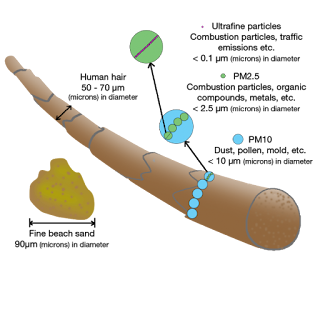GENERAL QUESTIONNAIRE ON PARTICULATE MATTER
GENERAL QUESTIONNAIRE ON PARTICULATE MATTER
April ‘2021
1. What is particulate matter?
Particulate matter (PM) has a diameter of
or below 10 microns and is referred to as PM10. Dust particles with a diameter
of less than 2.5 microns are referred to as PM 2.5 or PM 1 for particles below
1 micrometer.
Particulate matter comes from multiple sources, and is generated during the
combustion of fossil fuels and wood. Fine dust is also generated by abrasion
and by airborne dust. Other emissions, such as from agricultural sources
(sulfur oxides, ammonia, nitrogen oxides and volatile organic compounds-VOC)
also impact human health.
The control of particulate matter pollution is of considerable
importance in the protection of human health: PM10 fine dust particles are able
to enter the bronchial tubes and finer particles may migrate unhindered into
the deepest airways all the way into the blood stream. This particulate matter
causes inflammatory reactions of the respiratory tract, which can lead to
serious health problems such as COPD, bronchitis, lung cancer but also strokes
and circulatory problems.
2) Which category of particulate matter is most harmful to human
health ?
How does air polluted with particulate matter affect human
beings ?
Regarding the size of particles, the smaller the particle size the
greater will be the damage the cause to the living bodies. For the chemical
composition, the presence of silica and asbestos particles exerts destruction
of the respiratory vessels and the whole system damage. Particle size less than
2.5 micrometers in diameter is more harmful to human beings cause particles can
affect both your lungs and your heart.
3) Particulate matter, how small is it?
Particulate matter is a collective name for all particles that are
present in the air. The larger particles like dust and pollen are visible, but
the smaller particulate matter is so small you cannot see it. This is what
makes particulate matter an intangible subject, you cannot see it and therefore
you do not know it is there. However, this does not mean that it does not
affect your health. Research shows that particulate matter affects your health
at all concentrations and especially the smallest particles are the most
harmful to your body. But how small is particulate matter actually?
Particulate matter is, based on the size of the particle,
classified in four groups: PM10, PM2.5, PM1 and Ultra-fine particulate matter.
To clarify how small this really is, we compare the size of the largest
particle from each particulate matter group with the diameter of a human hair.
4) What is PM10 ?
Particulate matter that is classified as PM10, are all particles
that are smaller than 1/5th of a human hair. These particles are smaller
than 0.001 cm. By comparison, the largest PM10 particle fits 1.000 times in 1
cm.
Examples of PM10 particles are pollen, fungi and red blood cells.
5) What is PM2.5 ?
Particulate matter that is classified as PM2.5, are all particles
that are smaller than 1/20th of a human hair. These particles are smaller
than 0.00025 cm. By comparison, the largest PM2.5 particles fits 4.000 times in
1 cm.
Examples of PM2.5 particles are bacteria, combustion particles and
organic compounds.
6) What are PM1 and Ultra-fine particulate matter
PM1 is, together with Ultra-fine particulate matter, the smallest
particulate matter and also most dangerous to your health. These particles are
so small that they easily pass through the lung vesicles and reach the entire
body. Ultra-fine particulate matter even ends up in the brain.
PM1 particles are 1/50th of a human hair and are smaller than
0.0001 cm. By comparison, the largest PM1 particle fits 10.000 times in 1 cm.
The largest Ultra-fine particle even fits 100.000 times in 1 cm.
Examples of PM1 and Ultra-fine particles are traffic emissions,
combustion particles, cigarette smoke and viruses.


sir .more mcq send for welfare departmental exam
ReplyDeletevery very nice sir thnx
I read your whole blog it was very informative do please check out this website: https://tractorguru.in
ReplyDeleteThis comment has been removed by the author.
ReplyDeleteThank you for sharing this blog with us. I learned a lot from it, so we appreciate it. please see our site : https://www.mydentistnow.com/
ReplyDeleteThank you for this blog
ReplyDeleteThanks for Sharing This Useful Information!
ReplyDeleteParticulate Matter Control Devices
Amazing article, thanks for sharing. Also do check my Indo Farm Tractor page.
ReplyDeleteThank you for sharing this valuable information. Indian human hair wholesale exporters in Chennai careful not to pull on your natural hair. Store the wig on a wig stand or in its original packaging to maintain its shape.
ReplyDeleteIf you're looking to make your brand or event truly stand out, I highly recommend Customised T-Shirts Manufacturers like JSK Gifts and Awards. They create high-quality, personalized T-shirts perfect for corporate events, sports teams, and promotional activities. Great for boosting team spirit and brand visibility!
ReplyDelete
ReplyDeleteGreat insights! 🌟 Sunflower Lecithin Based Liposomes truly boost nutrient delivery. Lipsobio offers some excellent advanced liposomal vitamins and minerals worth checking out!
Great insights shared here about New Zealand travel requirements! The NZ Visitor Visa process can seem complex at first, especially for travelers who want to explore the country for tourism, business, or family visits. What really helps is having the right guidance from trusted experts who understand New Zealand’s visa regulations in detail.
ReplyDelete